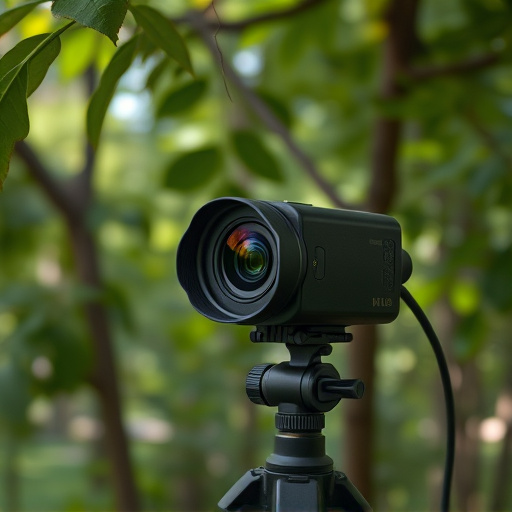The text introduces a Remote Viewing Nanny Surveillance System, leveraging psychic abilities for discreet monitoring of children or vulnerable adults. It details the system's components, setup process, and conducting signal sweeps, emphasizing the importance of calibration, environmental awareness, and noise reduction to ensure accurate remote viewing. Advanced systems use RF detectors with frequency hopping techniques, but challenges include interference from everyday electronics. Regular testing and secure app configurations are crucial for optimal performance and privacy protection.
Discover the power of remote viewing with this comprehensive guide on RF detector sweep hidden camera tutorials. Learn how a remote viewing nanny surveillance system can enhance your security, allowing you to monitor activities from afar. This article breaks down the process into accessible sections: understanding remote viewing’s applications, unpacking the RF detector’s components and functionality, setting up your system, conducting effective sweeps, exploring advanced techniques, and avoiding common pitfalls.
- Understanding Remote Viewing and Its Applications
- Unpacking the RF Detector: Components and Functionality
- Setting Up Your Nanny Surveillance System
- Conducting a Sweep: Techniques and Tips for Success
- Advanced Techniques and Common Pitfalls to Avoid
Understanding Remote Viewing and Its Applications
Remote viewing, often shrouded in mystery and intrigue, refers to the alleged psychic ability to perceive and describe locations or events remotely. While it’s a concept frequently explored in science fiction and parapsychology, remote viewing has practical applications in various fields, including nanny surveillance systems.
In the context of a Remote Viewing Nanny Surveillance System, this peculiar skill can be utilized to monitor and ensure the safety and well-being of children or vulnerable individuals without their immediate knowledge. It offers a discreet approach to supervision, where professional viewers can detect potential hazards, unusual activities, or any suspicious behavior from a distance using only their heightened senses. This innovative technique has gained traction as an alternative or supplemental method for parental control and security.
Unpacking the RF Detector: Components and Functionality
When you receive your RF detector, carefully unpack it and familiarize yourself with its components. A typical remote viewing nanny surveillance system includes a main unit, an antenna, and a power adapter. The main unit is where all the magic happens; it processes signals received by the antenna and displays them on the connected monitor.
The antenna is crucial as it picks up radio frequency (RF) signals from hidden cameras or other electronic devices. Its design and placement can significantly impact signal strength and clarity, so positioning it strategically is key. The power adapter ensures your system stays energized, allowing you to remotely view your surroundings at all times.
Setting Up Your Nanny Surveillance System
Setting up a remote viewing nanny surveillance system is an essential step in ensuring your peace of mind while keeping a close eye on your loved ones. Start by selecting a reliable and high-quality camera that offers both video recording and live streaming capabilities. Ensure it’s compatible with your preferred remote viewing app, allowing you to monitor activity from anywhere using your smartphone or computer. Position the camera discreetly in areas where you need surveillance, such as near playrooms, bedrooms, or common areas.
Connect the camera to a stable power source and ensure a strong, secure Wi-Fi signal reaches the device. Configure the app to access the camera’s feed, ensuring privacy through secure login details. Test the system by remotely viewing live footage and checking recording quality. Regularly update firmware and software to maintain optimal performance and security against potential hackers or interference.
Conducting a Sweep: Techniques and Tips for Success
Conducting a sweep with a remote viewing nanny surveillance system requires careful technique and attention to detail. Start by ensuring your device is properly calibrated and tuned to detect any potential signals. Move methodically through the area of interest, maintaining a consistent pace and coverage. Keep an eye out for subtle anomalies in the environment, such as unusual reflections or interference patterns that could indicate the presence of a hidden camera.
Utilize the full range of your device’s capabilities, adjusting settings as necessary to optimize signal detection. Be mindful of potential sources of interference from everyday electronics, and take steps to minimize these, such as moving away from large appliances or electronic devices. Regular breaks can help maintain focus, and taking notes throughout the process will aid in identifying any recurring patterns or anomalies that could indicate a hidden camera’s location.
Advanced Techniques and Common Pitfalls to Avoid
When employing an RF detector for hidden camera sweeps, especially in sophisticated nanny surveillance systems, advanced techniques can significantly enhance accuracy. One such method is frequency hopping, where the device rapidly switches between radio frequencies, making it harder for hidden cameras to lock onto a stable signal. This technique requires a high-sensitivity detector capable of detecting miniscule variations in frequency.
However, even with these advanced methods, there are common pitfalls to avoid. One major issue is interference from other electronic devices. The remote viewing process can be disrupted by everyday objects like microwaves or cordless phones. To counter this, professionals suggest using a sweep in a controlled environment, minimizing external electronics, and utilizing the right settings to filter out noise. Additionally, false positives are common; certain appliances and technologies may mimic camera signals, requiring careful analysis and cross-referencing with other detection methods.
The art of remote viewing, as explored in this tutorial, offers an intriguing approach to nanny surveillance. By utilizing an RF detector sweep, individuals can gain a powerful tool for non-intrusive monitoring. Understanding the technology and its applications opens doors to effective hidden camera setups, ensuring peace of mind for parents and employers alike. With the right knowledge and equipment, remote viewing becomes a valuable asset in today’s digital age, allowing one to navigate the complexities of surveillance with precision and confidence.
